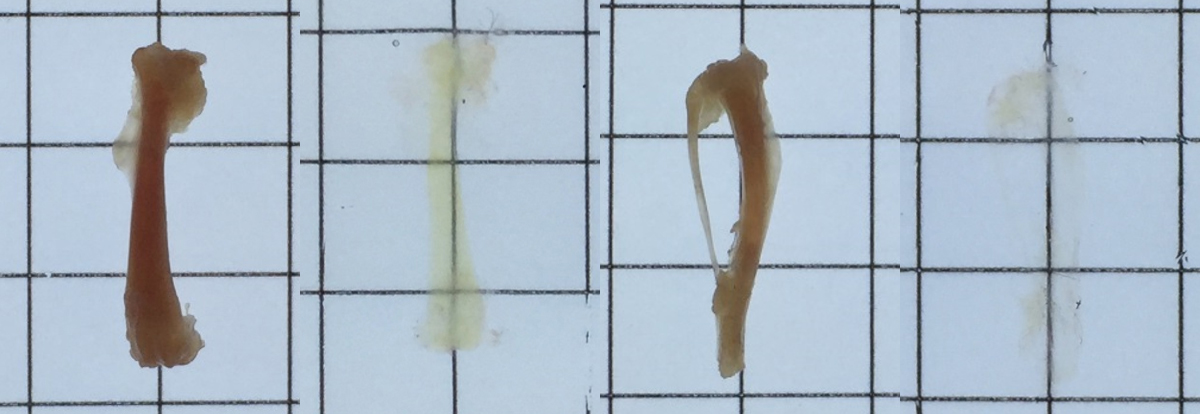

Just to be clear, scientists are still very far from re-creating The Invisible Man. But recently they’ve learned to make see-through brains and ghostly rat bodies, and now they’ve even created transparent bones.
Our skeletons are made up of living cells encased in calcium and collagen. The cells build and remodel our bones, and make new blood cells. But we don’t know a lot about how they’re arranged, or how they behave.
That’s because until now, the two main ways of seeing inside a bone were pretty destructive. One way is to mash up the bone and extract the cells— which is a good way to count the cells, but tells us nothing about their original locations. The second way is to slice the bone into paper-thin sections for microscopy; this preserves the cells’ locations, but doesn’t really show the big picture.
The new method of making bones transparent, described today in Science Translational Medicine, gives the best of both worlds by showing all the cells in their proper places. Caltech biologist Viviana Gradinaru and her team demonstrated the technique in mouse bones, and they hope it could eventually shed light on osteoporosis and other human diseases.

“Bone clarity allows for a whole range of questions that were not possible to previously address,” says Corey Neu, a mechanical engineer at the University of Colorado Boulder, who was not involved in the study. He says he expects the technique will be helpful in studying cell aging, bone cancers, the healing process, and more.
How it works
The bone-clearing magic relies on a technique developed in 2013, called “Clear Lipid-exchanged Acrylamide-hybridized Rigid Imaging/Immunostaining/In situ hybridization–compatible Tissue hYdrogel.” Mercifully, the creators call it CLARITY for short.
CLARITY was originally developed to see inside soft tissues. But by adding some extra steps, Gradinaru and her team managed to see inside the femurs, tibiae, and vertebrae of transgenic mice.
Their technique involves removing the calcium and using chemicals to wash away fats and blood residue, which can cloud the view of the cells. A hydrogel helps to preserve the bone’s 3D architecture, and helps the chemicals flow into the bone. A stir plate keeps the fluids moving, helping the chemicals to penetrate deep into the bones.
At the end of the 28-day process, what’s left is a transparent, gelatinous, bone-shaped blob, wherein the team could see cells fluorescing.
Neu says that his lab has used chemicals to make bone tissue clearer, but never this clear. The genius of the new process lies in the fact that it removes the minerals without destroying the cells, and that it uses common chemicals that are easily available to other scientists, says Neu.
But hang on to your invisibility cloak: the technique won’t work in a living organism, since the bones need to be stirred around with a bunch of chemicals for several weeks.
It will also be a challenge to scale up the process to turn human bones transparent; the chemicals need to diffuse through the bones, so larger bones would take a lot longer. Gradinaru says she would probably cut the bone into smaller pieces to make it work in a reasonable timeframe.
A new view
Gradinaru and her team have already used the new technique to learn how an experimental osteoporosis treatment may help rebuild bones.
In preliminary tests, antibodies that block the sclerostin protein, which inhibits bone growth, increased patients’ bone density and reduced their risk of fractures. By dosing mice with the antibodies and then looking into their bones, Gradinaru’s team saw that even a very short treatment led to increases in osteoprogenitor cells, which can turn into bone-building cells.
In addition to testing new drugs, the imaging process provides a new view of the cellular activity within healthy and diseased bones, which could lead to insights that help people with skeletal disorders.